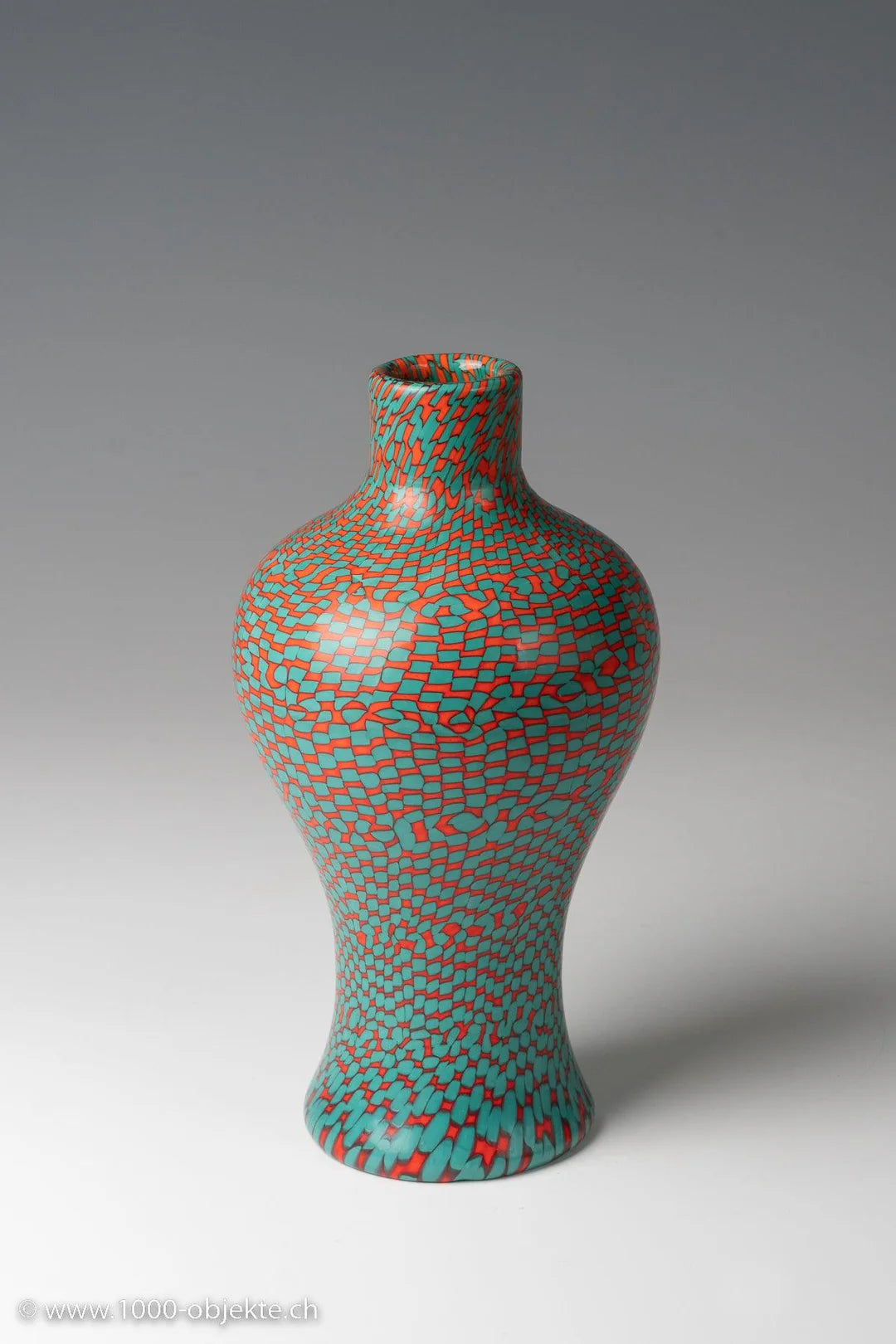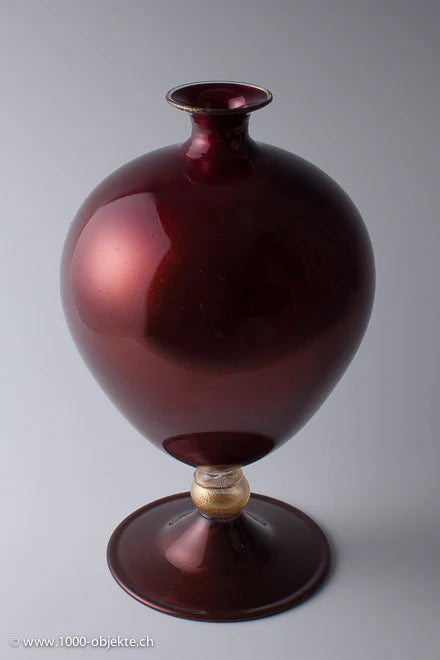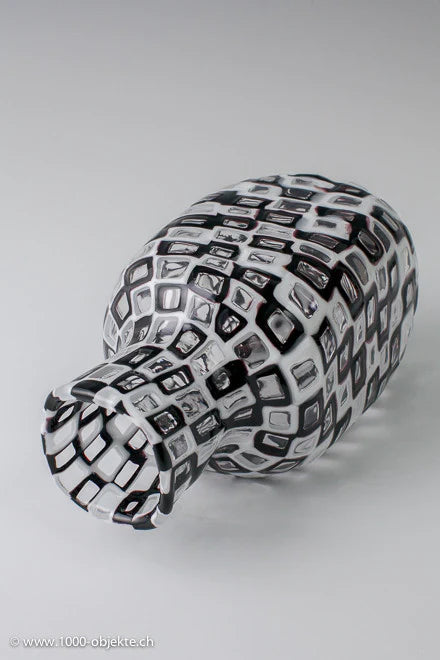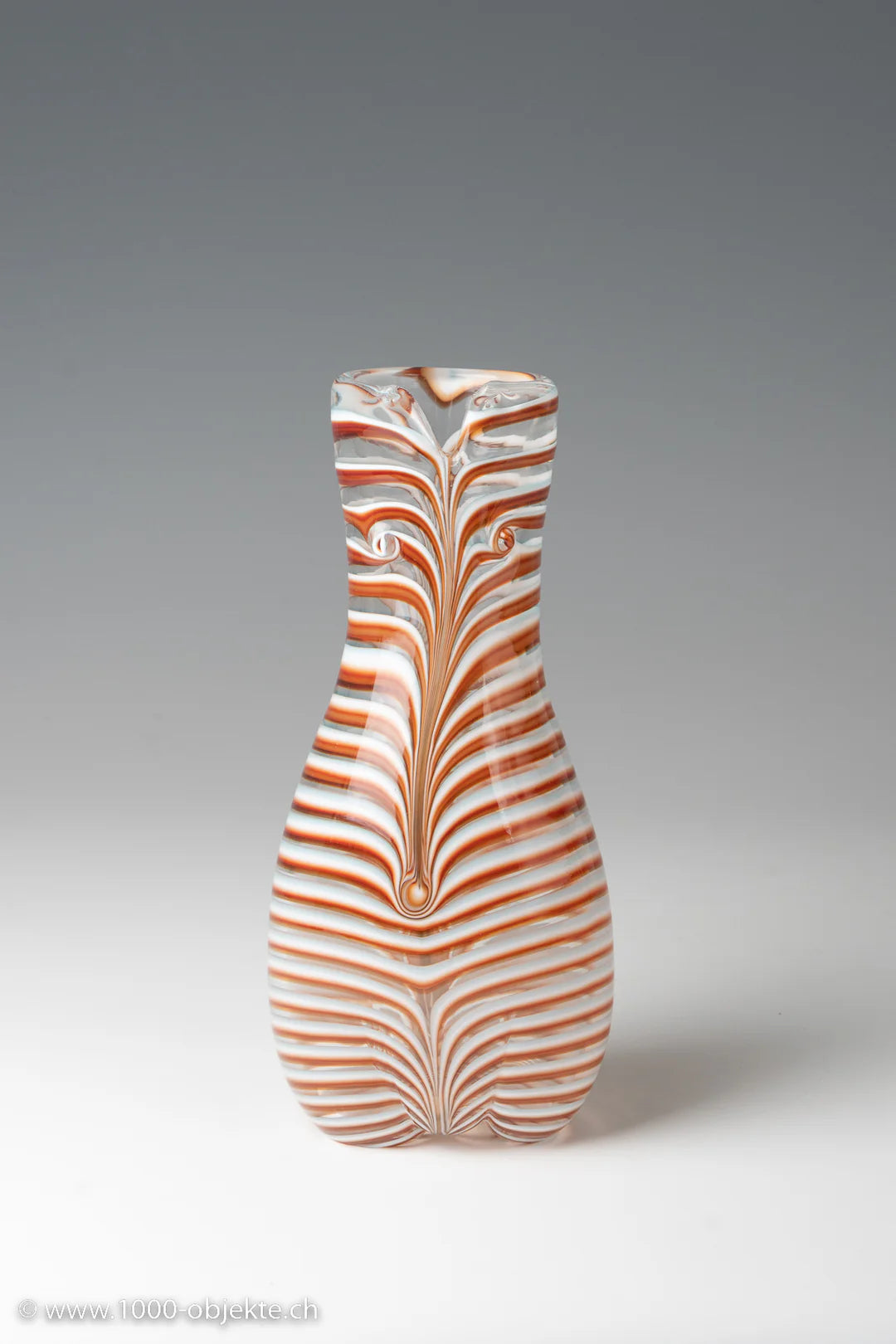Paolo Venini (1895 – 1959): Glass Objects created by a Visionary
Imagine a world where glass, once considered a humble practical material, is transformed into breathtaking works of art. Venini – a visionary Italian glassmaker – was a master of this transformation. His objects are more than mere vessels; Paolo Venini’s glass vases and vessels are sculptures that capture the essence of light, color, and form. Venini's innovative techniques and collaborations with renowned artists have elevated glassblowing to an entirely new level, creating objects that are both functional and deeply expressive.
Pivotal Role in Revitalizing the Artistry of Glassmaking
“Milanese by birth and Muranese by choice, Paolo was a skilled businessman who
was sensitive to the contemporary trends in art as well as the
demands of the international market. His stellar attention to detail
in the search of new mixtures of glass colors and shapes almost left
him without eyesight.“ – luminaire.com
Image with text
Pair large text with an image to tell a story, explain a detail about your product, or describe a new promotion.
The Beginnings: Vetri Soffiati Muranesi Cappellin Venini &C.
In the heart of Murano, Italy, a centuries-old tradition ofglassmaking has flourished. Paolo Venini, a leading figure of the20th century, played a pivotal role in revitalizing this ancientcraft. Born in a small town near Milan in 1895, Paolo Venini initially pursued a legal career but soon found his true passion in glassmaking.
Paolo Veniniand the Venetian antiquarian Giacomo Cappellin foundedthe company "Vetri Soffiati Muranesi Cappellin Venini & C. The artist Vittorio Zecchin, decidedto join in the role of Artistic Director.The factory aimed torevive the region's glassmaking heritage by reuniting skilledartisans and leveraging their expertise. However, their plans weredisrupted by the passing of another associate (Andrea Rioda) andlater by the dissolution of the trio itself, as Cappellin decided toventure out on his own.


Venini & C.
Despite these setbacks, Paolo Venini emerged as a leading figure in Murano's glass industry. Renaming his company Venini & C., he developed a unique aesthetic that was both innovative and refined.
Venini embraced contemporary artistic trends, collaborating with talented artists to create limited edition pieces.
From 1925 onwards, Venini established a distinctive aesthetic that defined his company's identity. Embracing contemporary artistic and architectural trends, he collaborated with renowned international artists to create exclusive limited editions. His innovative approach deviated from the prevailing Novecento style, as he translated his creativity into modern forms and experimental textures. Despite his reputation for eccentric modernist designs, Venini also developed a refined, elegant style that became a hallmark of his work. His commitment to quality was evident in his personal oversight of every production step, ensuring high standards for both craftsmanship and design.
Paolo Venini Designs
e Compagnia
“& C.” is an abbreviation and stands for "e Compagnia," which in Italian means "and Company." For his brand Paolo Venini cooperated with many skilled artists & designers through the years.
• Vittorio Zecchin, the appointed Art Director, reinvigorated the Murano glass industry with his ingenious designs. Inspired by ancient vases, Zecchin's work featured delicate, simple shapes that contrasted with the intricate designs of the era.
• In the late 1920s, Venini's brother Franco joined the company, conducting groundbreaking chemical research. His innovations resulted in unique colors exclusive to Venini, solidifying the company's competitive edge.


Scarpa & Venini
• Following Zecchin's departure, renowned Italian sculptor Napoleone Martinuzzi took the helm as Venini's Art Director. By 1928, he introduced his own innovative designs, including the remarkable vetro pulegoso technique, the use of glass paste for miniature animals, and the innovative incamiciato (double-layered glass) method. However, Martinuzzi's tenure was relatively brief, as acclaimed Italian architect Carlo Scarpa assumed the role in 1932.
• Scarpa's decade-long collaboration with Venini revitalized the company with fresh concepts and refined techniques. He pioneered new surface treatments like hammered, smoothed, incised, and corroded finishes. In addition, Scarpa perfected existing techniques, including laced, brush-stroked, and submerged methods. By reviving older techniques like half-filigree and milk-glass, Venini's designs became even more distinctive.
• Carlo's son, Tobia, also contributed significantly to Venini's legacy. Renowned for his Occhi (eyes) series, Tobia's creations embodied the exquisite and psychedelic aesthetics of the 1950s, contrasting with his father's more refined approach.
Fulvio Bianconi & Venini
• Following a wartime hiatus, Venini resumed production in the 1940s, collaborating with renowned Milanese architect and designer Gio Ponti. Ponti's vibrant and distinctive designs contributed to the company's recovery, providing a much-needed boost after the war.
• The 1950s as a whole marked a golden era for Venini. Despite economic challenges that forced many glassmakers to simplify their designs, Venini hired the talented Fulvio Bianconi, a leading figure in Murano's renaissance. Bianconi, an Italian illustrator and caricaturist, joined Venini in 1947. His innovative approach infused the glass industry with energy and modernity, transforming each piece into a work of art. His designs were characterized by sensuality and natural fluidity, earning him international acclaim for pieces like the “fazzoletto” vase.

Most Iconic Pieces & Series – Paolo Venini Glasswork of
the 1950s
Dama
The "Dama"
series by Paolo Venini was first presented at the 1954 Venice
Biennale. This limited series of difficult execution is considered one of the most refined examples of Venini rare murano glass production during the 50s.
It is a collection of elegant vases characterized by their slender, elongated forms and intricate geometric patterns. The vases are crafted using the millefiori technique, which involves fusing together tiny glass rods of different colors to create complex designs.

Zanfirico Reticello
The “Zanfirico Reticello” series by Paolo Venini is a collection of glass vases characterized by their intricate latticework patterns and vibrant colors. The name "Zanfirico" refers to the technique used to create the delicate, web-like structure, which involves fusing together thin glass rods in a criss-crossed pattern.
Bottiglie Incise
The “Bottiglie Incise” series by Paolo Venini is a collection of glass bottles characterized by their intricate, hand-engraved patterns. The name "Incise" means "engraved" in Italian, referring to the delicate lines and designs that adorn the surface of the bottles. The patterns are typically geometric or floral in nature, and are created using a cold engraving technique that involves scratching or cutting into the surface of the glass.
The Bottiglie Incise series was first introduced in the 1950s and quickly gained popularity among collectors and enthusiasts of Murano glass. The series is considered a classic example of Venini's work and continues to be highly sought-after by collectors today.
Murano Lamps by Venini & C.
Furthermore, Paolo Venini was involved in the design of murano lamps, but he often collaborated with other designers. While he was a visionary and skilled glassmaker himself, Venini recognized the value of diverse perspectives and expertise. He frequently partnered with renowned designers and architects, such as Carlo Scarpa, Gio Ponti, and Fulvio Bianconi, to create iconic and innovative lamp designs.
The Legacy Remains: Rich History & Innovative Spirit of PaoloVenini’s Glass Designs
Venini's legacy continued after his passing in 1959, with the company transitioning through generations of family ownership. In 1985, the company was eventually sold, but its enduring contributions to the glass industry remain a testament to its rich history and innovative spirit. The frequent repetition of classic Venini glass designs, whether due to tradition or ongoing archival efforts, can pose a challenge for collectors. While the quality and design may be based on authentic originals, contemporary technologies and processes have significantly altered the nature of Venini glass. Despite these changes, Venini & C. remains one of Murano's most esteemed glass firms, synonymous with exceptional craftsmanship and innovative Italian style.
Authentic Rarities – 1000 Objekte
Are you interested in purchasing an iconic glass object created by the famous Paolo Venini? In this collection, Peter Grünbaum showcases an entire treasure trove of Venini rarities: Select your favorite item from our collection here »
Feel free to reach out if you have any questions about my collection or if you're looking for a rare vase to complete your own. My current collection of glass rarities comprises 5,000 unique vases and objects. Should you have any inquiries or wish to view the collection in Zurich, please don't hesitate to contact me.




























